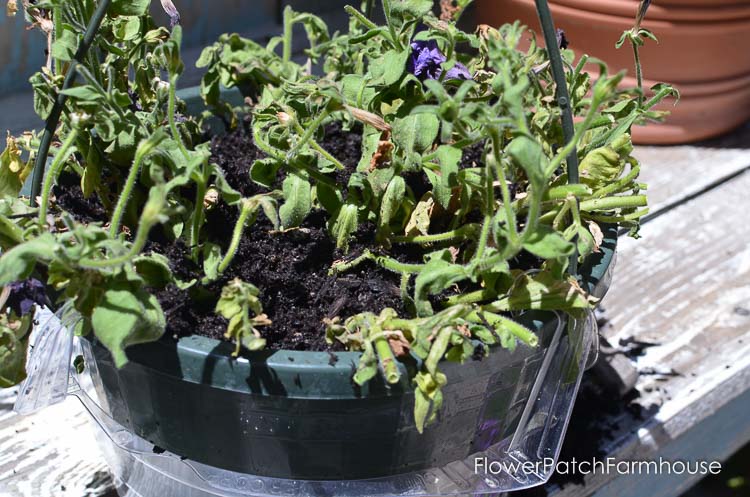To revive dying petunias, ensure they receive adequate sunlight, water them thoroughly and add fertilizer to promote growth and recovery. Petunias, like all plants, require sufficient sunlight for photosynthesis, so place them in a location with at least six hours of direct sunlight per day.
Check the soil moisture regularly and water the plant deeply when the top inch of the soil feels dry. Additionally, fertilize the petunias every two weeks to provide the necessary nutrients for rejuvenation. By following these steps, you can revive your dying petunias and help them thrive again.

Credit: www.gardenerreport.com
How to Revive Dying Petunias: Step by Step Guide
Diagnosing The Problem
Petunias, like any other plant, can face decline and ultimately die if not properly cared for. Recognizing the signs of dying petunias is crucial in finding the root cause. Wilted or discolored leaves, stunted growth, and shrinking flowers are key indicators.
Once the signs are identified, it becomes easier to diagnose the specific problem at hand. It could be due to overwatering, underwatering, nutrient deficiencies, pests, or diseases. Analyzing the environmental conditions, such as sunlight exposure, soil quality, and temperature, is also important.
By understanding the underlying issue, appropriate measures can be taken to revive your dying petunias and provide them with the necessary care they need to thrive. With proper attention and adjustments to their surroundings, your petunias can flourish once again.
Common Issues Affecting Petunias
Petunias are beautiful flowers that can be easily revived with proper care. Insufficient sunlight can cause them to wilt and lose their vibrancy. Overwatering or underwatering can also be detrimental to their health. It’s important to find the right balance to avoid root rot or dehydration.
Nutrient deficiency is another common issue that can affect petunias, so using a balanced fertilizer is crucial. Pests like aphids or spider mites can infest petunias, causing damage and hindering their growth. Regularly inspecting and treating for pests is essential.
Petunias are also susceptible to diseases such as powdery mildew or root rot, so keeping them in well-drained soil and practicing good hygiene is key. By addressing these common issues, you can successfully revive dying petunias and enjoy their beauty for longer.
Implementing Revival Methods
Reviving dying petunias requires implementing various methods. One way is adjusting sunlight exposure, ensuring they get the right amount of light. Proper watering techniques are vital, providing adequate moisture without overwatering. Supplying necessary nutrients through fertilizers encourages petunias to recover.
Dealing with pests effectively is crucial, using natural or chemical methods. It’s also essential to address common diseases that affect petunias promptly. By following these steps, your petunias will have a better chance of coming back to life.
Guide To Reviving Petunias
To revive dying petunias, it is crucial to assess the plant’s health. Start by pruning and removing damaged parts to stimulate new growth. Repot the petunias using proper soil to provide essential nutrients. Ensure the pot has appropriate drainage to prevent waterlogging.
Mulching around the plants helps retain moisture and prevents its loss. Establish a regular fertilization and feeding schedule to promote healthy growth. Implement pest control measures to safeguard the petunias from infestations. Lastly, prioritize disease prevention by maintaining good hygiene and promptly treating any signs of illness.
By following these steps, you can revive and rejuvenate your petunias, allowing them to thrive once again.
Maintaining Healthy Petunias
Maintaining healthy petunias involves creating a suitable environment that promotes their growth and vitality. Regular monitoring and care are essential for their long-term health and blooming. To revive dying petunias, ensure they are planted in well-draining soil and receive ample sunlight.
Water them regularly but avoid overwatering, as this can lead to root rot. Provide adequate nutrition through regular fertilization with a balanced plant food. Prune the plants regularly to promote bushy growth and remove any dead or yellowing leaves. Pest control is crucial, so keep an eye out for common petunia pests and treat them promptly.
Lastly, ensure proper air circulation to prevent fungal diseases. By following these tips, you can revive your dying petunias and enjoy beautiful, healthy blooms.
Frequently Asked Questions For How To Revive Dying Petunias
How Can I Revive Dying Petunias?
To revive dying petunias, start by cutting back the dead or withered parts of the plant. Ensure they get enough sunlight, water them regularly, and fertilize with a balanced plant food. Remove any pests or diseases and provide proper ventilation.
With these steps, your petunias have a good chance of thriving again.
Why Are My Petunias Dying?
There are several reasons why petunias may be dying. Common causes include lack of water, improper drainage, pests or diseases, extreme weather conditions, over-fertilization, or poor soil quality. Identifying and addressing the underlying issue will help revive your petunias.
How Often Should I Water Petunias?
Petunias need regular watering, typically once a day or every two to three days. The frequency can vary depending on the weather, container size, and soil type. It’s important to ensure the soil is moist but not waterlogged. Consistency is key to keeping your petunias healthy.
Conclusion
Reviving dying petunias can be a challenging but rewarding endeavor for any gardener. By following these simple steps, you can give your petunias a new lease on life. Firstly, ensure that you check the soil moisture levels regularly and water as needed.
Remember not to overwater, as this can lead to root rot. Next, prune any damaged or dead leaves and flowers to encourage new growth. Additionally, fertilize your petunias with a balanced fertilizer to provide them with the nutrients they need to thrive.
Furthermore, protect your petunias from extreme weather conditions by providing shade or shelter when necessary. Lastly, maintain a regular maintenance routine by deadheading spent blooms regularly. With a little care and attention, your petunias can flourish once again, adding beauty and vibrancy to your garden.

